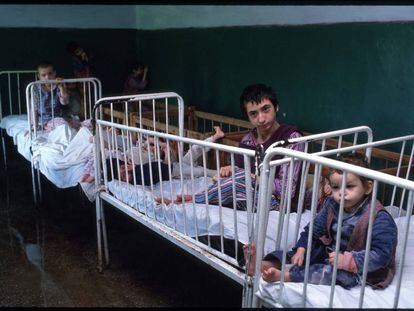The story was told like no one else by Charles Dickens in works such as Oliver Twist or Great Expectations: an orphan boy who grows up in an environment as hostile as that of the beginnings of the Industrial Revolution in nineteenth-century England, spurred on by hunger and misery. Now, a group of scientists has analyzed the remains of dozens of children using modern forensic techniques, confirming the story told by the writer. Most of them grew up and died malnourished. The development of those who were 12 years old corresponded to that of eight-year-olds. There are several with bone injuries compatible with physical punishment. The reality was even harsher than that narrated by the master of social realism. While their characters grow up, get older and have a relatively happy ending, many of this study published in the scientific journal PLoS ONE did not make it past adolescence.
A few years ago, the construction of a local museum next to the church of Fewston (in the county of Washburn, in central England) forced to unearth much of the old cemetery. For this they hired a company specialized in archaeological excavations. They had no idea what they were going to find. "My company, York Osteoarchaeology, took care of the osteological analysis of the skeletons, determining the age, sex and pathologies of the people buried in Fewston," says University of York archaeologist and co-author of the study, Malin Holst. "It was during this initial skeletal analysis that it became apparent that there were a lot of teenagers, which are not usually very common in cemeteries." In today's necropolises, most burials are of older people. In the past, before the advances of modern medicine and social protection, the pattern was different: next to the elderly, there were also many graves of newborns and young children who were carried away by some disease. But in Fewston, 54 of the 154 bodies recovered from the first half of the 20th century were boys and girls between the ages of seven and <>. Such an anomalous pattern forced us to delve into this story.
Read moreSuffering shrinks children's brains forever
The osteological study allowed scientists to determine how much these children suffered. Most had an age (determined by teeth) that did not correspond to that estimated according to the length and stage of development of their bones (which is used today, for example, to age immigrants). For example, the individual identified as SK 331, would be between 12 and 14 years old according to his teeth, but the bones correspond to those of a child of no more than eight years. The girl SK 262 died between the ages of 16 and 18, but her bones, without the characteristic that indicates the end of bone growth (epiphyseal fusion), correspond to those of a 10-year-old girl if her development had been normal. The malnutrition was confirmed by the poor growth (hypoplasia) they found on their teeth. This pathology of enamel, characterized by incomplete development of the same, usually occurs in childhood caused by poor nutrition and accumulation of diseases. This type of stress at an early age also affects brain development, as studies with children in orphanages in dictator Ceausescu's Romania have shown.
Of the 154 remains recovered from Fewston Cemetery, 54 were of young people under the age of 20. In the picture, one of the unearthed. John Buglass Archaeology
"Some of the children suffered from rickets and scurvy. We can diagnose these conditions because they leave traces in the bones," says Durham University bioarchaeologist and first author of the study, Rebecca Gowland. One of these traces is the lack of vitamins, so essential in this phase of child development. "For vitamin D deficiency, it's some tilting of the long bones and other changes. For vitamin C, it usually manifests itself in the form of porous lesions in certain parts of the skeleton," he adds.
Poor diet
To confirm malnutrition, the researchers turned to isotopes, but this time carbon and nitrogen. The differences in the ratio of nitrogen-15 isotope and carbon-13 allow us to know the relative weight of animal and vegetable proteins in the diet. The low levels of this ratio found in almost all young people contrast with the higher levels observed in the buried identified as local. This would indicate that they died after many years of poor or no diet in meats or animal-derived foods, such as dairy.
Osteological analysis of the children showed, as the authors write, that "their sufferings and privations were written on their skeletons." Durkham University
Archaeologists from York took the remains to the bioarchaeology laboratory of their colleagues at Durham University. Between them, they used sophisticated forensic techniques to analyze all the bodies. Many of the buried elders and a young child were identified by their tombstones or plaques placed on coffins. But the young men were in unmarked graves. They were able to determine their age at death thanks to the development of their teeth, but it was another thing to know who they were and where they came from. One of the few tools to know the origin of a person of unknown origin is to extract the proteins present in the tooth enamel and analyze the ratio of different chemical elements present. Two of the most fruitful are the isotopes (variations of the same element according to the number of neutrons) of strontium and oxygen.
"As we develop our teeth, the chemical ratios of strontium and oxygen within them reflect the local geology and the water we drink," says Gowland. "We knew that the skeletons were not local because the strontium and oxygen isotope values were very different from those observed in the teeth of individuals known to be native to the region. Instead, for many of the children they were consistent with the London area and surrounding areas," he adds.
A group of children, during the Industrial Revolution in the UK.Topham Picturepoint/Cordon press
Orphans transferred
During the beginning of the Industrial Revolution, late eighteenth and early part of the nineteenth century, there was a great migration from the countryside to industrial cities such as Leeds or Manchester. But it also occurred in the opposite direction, from the poorest neighborhoods of London or Liverpool, especially children, to the rural areas where many factories were located, especially the textile industry. In and around Fewston, there were five, with the largest, West House Mill, dedicated to spinning linen and cotton.
After the work of the scientists, the remains of the children and others unearthed received a second burial, once their bones told their story. Washburn Heritage Centre
In the archives of the village have been found several indentures, contracts between the patrons of West House and orphaned children (or abandoned by their parents) from hospices in London. These documents forced children to work in exchange for bed, food and education until the age of 21 or, in the case of girls, until they married. These asylums were what in the Anglo-Saxon world they called workhouse. These were not Hispanic-style orphanages, which provided shelter. They actually did it in exchange for work. Oliver Twist begins his story in one of these workhouses.
The picture painted by this research coincides with the memoirs of the Reverend Robert Collyer, son of orphans who were also apprentices, who worked between the ages of 8 and 14 at West House: "They called at 6 in the morning and we left at 8 at night with an hour to eat and rest. And if we had the opportunity to sit for a few moments when the supervisor was not in front to punish our little shoulders with his leather strap [...] and the result of all this was that the weaker children were so crippled that the memory of their twisted limbs still throws a rather sinister light to me on the Holy Scriptures," recalls in a fragment recovered by the authors of this research.
"The Fewston remains have been the only ones excavated in a rural cemetery in the north of England and are therefore unusual," Gowland replies when asked if the children's story is anecdotal or representative of the beginnings of the Industrial Revolution. "But there are a lot of rural cemeteries like Fewston. However, they are rarely excavated because this only happens if it is going to be urbanized," he adds. Two facts can frame the scope of the drama: official statistics mentioned in the study estimate that 195,000 children aged 5 to 14 who passed through one of the parish hospices in 1803 put an estimated number of children. And in 1845, in the cotton sector, 45% of workers were under 18 years old. As for the little ones in Fewston, once the children's bones told scientists what they had suffered, they were properly reburied, and their story is preserved at the Washburn Heritage Centre.
You can follow MATERIA on Facebook, Twitter and Instagram, or sign up here to receive our weekly newsletter.


/cloudfront-eu-central-1.images.arcpublishing.com/prisa/BRRQWHKHTBFDJJ6EREN2ZD5LLE.png)






